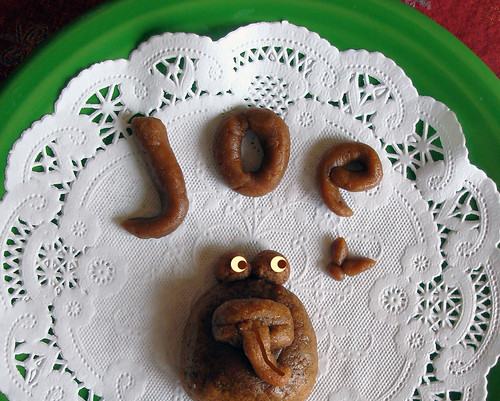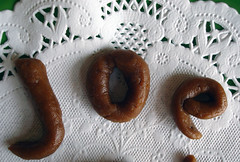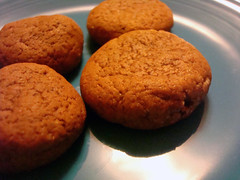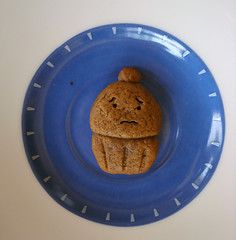
We love the Seattle Public Library. Not only is it a feat of architecture (designed by Rem Koolhaas) and a fantastic place for people-watching, but we find some of the best literary gems there (including arguably the best cookbook ever-- Cooking in WetLeather, a biker cookbook with the tag "Ride Safe, Eat Dangerously"--but we digress.)


Our most recent discovery though was the first edition print of Betty Crocker's Cooky Book, which, packed as it is with recipes and little historical tidbits, led us to the legend of the Joe Frogger.
What is a Joe Frogger? According to Betty, they are "famous molasses cookies made long ago by old Uncle Joe of Marblehead, Mass. The cookies are as plump and dark as the little frogs that lived in the pond near Joe's cottage." Not too sweet, and with a crisp texture, they are a solid cookie indeed (picture of a "proper" Joe Frogger above left--we've taken liberties with the shapes of the others in this writeup).

But a little bit of further digging revealed a life as rich in history as the cookie is plentiful in molasses. Joe Brown, aka "Black Joe", was born in Massachusetts 1750 to a black mother and Native American father--a time when most wealthy Marblehead families still owned several slaves. Unfortunately, we weren't able to find much about his youth, but it is speculated that by the time he reached manhood he "must have been gainfully employed for his name does not appear as one of the black "drifters" forced out of Marblehead in 1788, when...Town Meeting ordered all former slaves to find work or leave".
Joe clearly had it going on though--he married a woman 22 years his junior, Lucretia Brown, and he even bought property in the area, a house on Gingerbread Hill (!). It was a lengendary spot, converted to a rooming house which was one of the few places in town where whites and blacks mixed freely. And oh, did it have a colorful reputation (from Marblehead Magazine)--
according to Marblehead Historian Joseph Robinson, "a more uncouth assemblage of ruffians could not be found anywhere." It would not be surprising if the term "Down bucket!" originated here, that fearful Marblehead expression warning those below that the contents of the chamber pot where about to be flung out a bedroom window.
Just thinking about these antics makes us hungry--and that's where the famous molasses cookies come into the picture--they were the tavern's signature food item.

But the Joe Froggers themselves were only named after Black Joe--they were not actually his invention. The cookie was apparently dreamed up by his wife Lucretia (aka "Aunty Crese"). The cookies, which keep for long periods, were named for her husband and the amphibians who lived in the pond by the house; because they keep for a long time, the cookies were an ideal choice for travel and were frequently taken on fishing trips and even longer sea voyages. There was also a lesser-known variation, the "Sir Switchels" which were popular too, described as a "thirst-quenching blend of water and molasses, which a touch of vinegar to cut the sweetness."
Unfortunately it's better to be the one the cookie's named after rather than the namer--while Black Joe has an impressive gravestone and is a part of Marblehead lore, Lucretia's resting place is not known (though apparently she does get a mention in the novel The Hearth and Eagle by Anya Seton. )
But perhaps the Marblehead Magazine sums it up best:
Still, as long as frogs continue to hatch in Marblehead ponds and the aroma of gingerbread fills Marblehead kitchens, the lives of Black Joe and Aunty 'Crese will be as sweetly remembered as the taste of their warm Joe Frogger.
We used Betty Crocker's version (which is vegan!); it can be found below, or in the Betty Crocker's Cooky Book.
Ingredients:
- 1/2 Cup Shortening
- 1 cup sugar
- 1 cup dark molasses
- 1/2 cup water
- 4 cups Gold Medal Flour
- 1 1/2 tsp. salt
- 1 tsp. soda
- 1 1/2 tsp. ginger
- 1/2 tsp cloves
- 1/2 tsp. nutmet
- 1/4 tsp. allspice
Directions: Mix well shortening and sugar. Stir in molasses and water. Measure flour by sifting. Stir dry ingredients together; blend into shortening mixture. Chill dough several hours or overnight.
Heat oven to 375 degrees. Roll dough 1/4 inch thick on floured board. Cut in 3-inch circles. Sprinkle with sugar. Place no a well-greased baking sheet. Bake 10 to 12 minutes. Leave on baking sheet a few minutes before removing to prevent breaking. Store in covered cookie jar. Makes 3 to 4 doz. cookies. Note: if you use self-rising flour, omit salt and soda.
Two additional notes: A few questions have come up as a result of this article. The first one is, are Joe Froggers delicious? Well. They're an old school cookie, very spicy and molasses-y, and not too sweet. We'll admit it openly though--we liked ours better with a dab of frosting on top.
The second question is "Why does Cuppie look so sad?". Well, you see, he's having a moment of identity crisis--"am I a cookie...or a cupcake?". It's a poignant moment indeed, speaking to all of those who have ever felt like the proverbial square peg.







